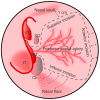Reconstruction of the Anterior Skull Base Using the Nasoseptal Flap: A Review
- PMID: 38201596
- PMCID: PMC10778443
- DOI: 10.3390/cancers16010169
Reconstruction of the Anterior Skull Base Using the Nasoseptal Flap: A Review
Abstract
The nasoseptal flap is a workhorse reconstructive option for anterior skull base defects during endonasal surgery. This paper highlights the versatility of the nasoseptal flap. After providing a brief historical perspective, this review will focus on the relevant primary literature published in the last ten years. We will touch upon new applications of the flap, how the flap has been modified to expand its reach and robustness, and some of the current limitations. We will conclude by discussing what the future holds for improving upon the design and use of the nasoseptal flap in anterior skull base reconstruction.
Keywords: anterior skull base reconstruction; expanded endoscopic endonasal surgery; nasoseptal flap; pedicled flaps; transnasal transsphenoidal pituitary surgery.
Conflict of interest statement
The authors declare no conflicts of interest.
Figures





References
-
- Zwagerman N.T., Wang E.W., Shin S.S., Chang Y., Fernandez-miranda J.C., Snyderman C.H., Gardner P.A. Does Lumbar Drainage Reduce Postoperative Cerebrospinal Fluid Leak after Endoscopic Endonasal Skull Base Surgery? A Prospective, Randomized Controlled Trial. J. Neurosurg. 2019;131:1172–1178. doi: 10.3171/2018.4.JNS172447. - DOI - PubMed
-
- Ivan M.E., Bryan Iorgulescu J., El-Sayed I., McDermott M.W., Parsa A.T., Pletcher S.D., Jahangiri A., Wagner J., Aghi M.K. Risk Factors for Postoperative Cerebrospinal Fluid Leak and Meningitis after Expanded Endoscopic Endonasal Surgery. J. Clin. Neurosci. 2015;22:48–54. doi: 10.1016/j.jocn.2014.08.009. - DOI - PubMed
Publication types
LinkOut - more resources
Full Text Sources

